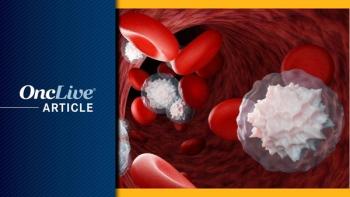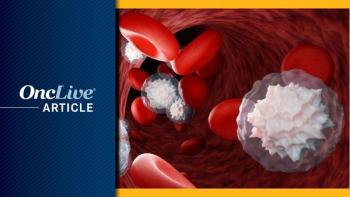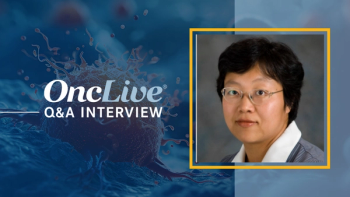
Addition of BET Inhibitor to Ruxolitinib Reduces Spleen Volume, Improves Symptoms in Myelofibrosis
The addition of CP-0610 to ruxolitinib (Jakafi) in JAK inhibitor-naïve patients with myelofibrosis induced splenic and symptomatic responses as early as 12 weeks.
Claire Harrison, MD
The addition of CP-0610, a selective and potent oral small molecule BET inhibitor, to ruxolitinib (Jakafi) in JAK inhibitor-naïve patients with myelofibrosis induced splenic and symptomatic responses as early as 12 weeks, according to preliminary data from a phase II study presented at the 2019 ASH Annual Meeting and Exposition, held December 7-10, in Orlando, Florida.
In the MANIFEST study, patients demonstrated splenic and symptomatic responses as early as 12 weeks, at which time 80% of patients had a spleen volume reduction (SVR) of ≥35% and 71.4% of patients had a total symptom score (TSS) improvement of ≥50%,1 reported Claire Harrison, MD. The combination was generally well tolerated; no adverse events led to study discontinuation.
“Whilst ruxolitinib, the first approved therapy for myelofibrosis, as shown in the COMFORT 1 study,2 delivers significant spleen volume and symptom improvement in approximately 40% of patients, the symptomatic improvement occurs in the setting of cytopenias in some agents, and additional agents with a different mechanism of action are postulated to be needed in order to deepen symptomatic responses and modify the disease in an unmet need patient population,” said Harrison, professor of hematology, Guy’s and St. Thomas’ Hospital, London, U.K.
BET proteins bind to acetylated histone lysine residues and function as co-activators of gene expression. They cooperate with the transcription factor NFκB to activate pro-inflammatory cytokine gene expression. CP-0610 downregulated pro-inflammatory cytokines in mouse models, and the combination of a BET inhibitor and ruxolitinib synergistically reduced splenomegaly, cytokine expression, bone marrow fibrosis, and the mutant allele burden.
Preliminary data from prior JAK inhibitor-treated patients in MANIFEST showed that CPI-0610 as monotherapy (arm 1) or “add on” to ruxolitinib (arm 2) was generally well-tolerated, and reduced spleen size, alleviated symptoms, improved levels of hemoglobin, and reduced transfusion burden, in patients with myelofibrosis, as well as suppressed proinflammatory cytokine and improved bone marrow fibrosis.
In her poster, Harrison presented preliminary data from arm 3 of MANIFEST, a global, multicenter, open-label study of CPI-0610 in combination with ruxolitinib in JAK inhibitor-naïve patients with myelofibrosis. Key eligibility criteria of arm 3 included a DIPSS risk ≥intermediate-2, ECOG performance status ≤2, platelet count ≥100 x 109/L, peripheral blood blast count <10%, anemia (hemoglobin <10 g/dL), spleen volume ≥450 cm3, absolute neutrophil count ≥1 x 109/L without the assistance of granulocyte growth factors, and at least 2 symptoms measurable (score ≥3) or a TSS of ≥10.
As of October 17, 2019, 30 treatment-naïve patients were enrolled in arm 3, 15 (50%) of whom are on treatment for at least 12 weeks. Dose modification of ruxolitinib or CP-0610 was required in 40%. Some 53.3% had primary myelofibrosis, 10% had post polycythemia vera myelofibrosis, and 33.3% had post essential thrombocythemia myelofibrosis. At baseline, the median platelet count was 369.5 x 109/L, the median spleen volume was 1,637 cm3, and the median TSS was 16. Fifty percent had high molecular risk mutations at baseline.
Patients were treated with CP-0610 at 125 mg on a 14-day on, 7-day off cycle, with a starting dosage of ruxolitinib, according to the baseline platelet count (10 mg twice daily with platelet count ≥100 x 109/L; 15 mg twice daily if platelet count was >200 x 109/L). Ruxolitinib dosage was increased by 5 mg twice daily per cycle from cycle 3, day 1 or thereafter, to a maximum dosage of 20 mg twice daily if upward dose titration criteria were met. CP-0610 dosage was increased from cycle 5, day 1 and thereafter by 25 mg once daily to a maximum dosage. All patients remain active on treatment for a median duration of 4 cycles (12 weeks).
“Encouraging early clinical activity is observed with this combination,” said Harrison. “Eighty percent of patients achieved a 35% reduction in spleen volume and 71% achieved a 50% reduction in TSS as early as 3 months after treatment.”
The median reduction in spleen volume at week 12 was 49.7%. Response was observed in patients considered to be high risk, including 86.7% of patients with DIPSS ≥int-2 and 80% of patients with hemoglobin <10 g/dL, and 53.3% of patients who were high molecular risk. The median change in TSS at week 12 was 60.3%.
In the 7 patients with elevated pro-inflammatory cytokines at baseline, median C-reactive protein (CRP) level was reduced by 57.1% and median interleukin (IL)-18 level was reduced by 85.7%. Normalization of CRP occurred in all 4 patients with abnormal CRP levels at baseline, and in 4 of 6 (66.7%) of patients with abnormal levels of IL-18 at baseline.
The benchmark for SVR for ruxolitinib alone at full dose in the JAK inhibitor-naïve population, per label, is 28.5 to 41.9%, noted Harrison.
Anemia occurred in 20% and thrombocytopenia in 16.7%. Thrombocytopenia was reversible and asymptomatic. Three patients had grade 3 anemia and 1 had grade 4 thrombocytopenia, which was the only grade 4 adverse event (AE) that required a 3-week dose interruption.
The most common nonhematologic AEs were diarrhea (26.7%), nausea (20%), constipation (20%), and mouth ulceration (20%), all of which were grade 1-2. There were no new or unexpected infections.
“Based on these preliminary data, this cohort has been expanded in the MANIFEST study and a phase 3 trial is being planned,” said Harrison.
References
- Harrison C, Patriarca A, Mascarenhas J, et al. Preliminary report of MANIFEST, a phase 2 study of CPI-0610, a bromodomain and extraterminal domain inhibitor (BETi), in combination with ruxolitinib, in JAK inhibitor (JAKi) treatment naïve myelofibrosis patients. Presented at: 2019 ASH Annual Meeting; December 7-10, 2019; Orlando, FL. Abstract 4164.
- Verstovsek S, Mesa RA, Gotlib J, et al. A double-blind, placebo-controlled trial of ruxolitinib for myelofibrosis. N Engl J Med. 2012;366:799-807.

























































































